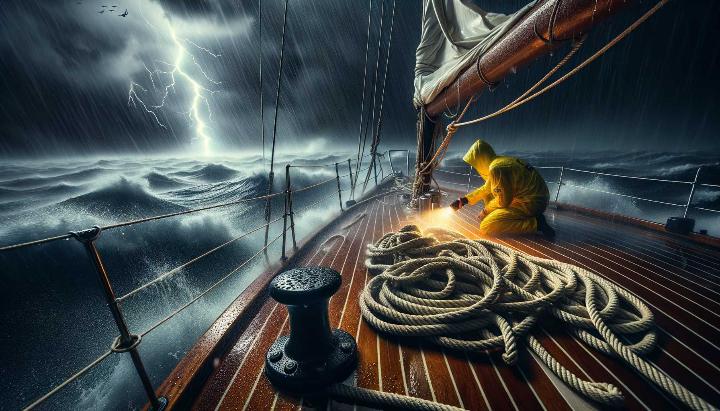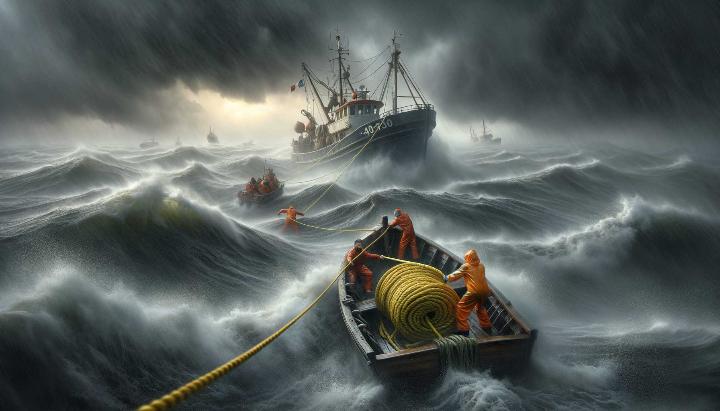Have you ever found yourself in a nautical nightmare, watching helplessly as your boat drifts dangerously close to jagged rocks? The culprit might be lurking right under your nose: the wrong marine rope. Understanding marine rope specifications and uses isn't just a matter of sailor's pride—it's a critical safety issue that can make or break your maritime adventures.
In this comprehensive guide, we'll navigate the intricate world of marine ropes, focusing on the powerhouse duo of nylon and polyester, while also exploring the often-overlooked potential of polypropylene. Whether you're a seasoned captain or a weekend warrior, mastering the nuances of rope specifications can elevate your boating experience from precarious to precise.
As Australia's leading rope manufacturer, iRopes is committed to empowering our customers with knowledge that goes beyond the sale. We'll unravel the mysteries behind tensile strength, working load limits, and UV resistance, equipping you with the expertise to make informed decisions for your specific marine applications. So, grab a cuppa and prepare to splice into the fascinating realm of marine ropes—your vessel's safety and your peace of mind depend on it.
Types of Marine Rope: Essential Guide for Boaters
As a seasoned sailor, I've learned that choosing the right rope can make or break your boating experience. Let's dive into the world of marine ropes and explore the essential types every boater should know.
Common Marine Rope Materials and Their Properties
When it comes to marine ropes, three materials stand out: nylon, polyester, and polypropylene. Each has unique properties that make it suitable for different applications on your boat.
- Nylon rope is the workhorse of the boating world. It's incredibly strong and stretchy, making it perfect for anchor and dock lines. The stretch acts like a shock absorber, reducing sudden jerks on your boat.
- Polyester rope is your go-to for low-stretch applications. It's UV-resistant and maintains its strength when wet, making it ideal for halyards and sheets.
- Polypropylene rope is the floating wonder. While not as strong as nylon or polyester, it's perfect for water sports and temporary lines where visibility is key.
I remember a time when I used the wrong rope for my anchor line - a polypropylene rope instead of nylon. Let's just say, it was a lesson learned the hard way during a stormy night!

Selecting the Right Rope for Specific Boating Applications
Choosing the right rope isn't just about material - it's about understanding your specific needs. Here are some tips:
- For anchoring, go for nylon. Its stretch helps absorb shock from waves and wind.
- For halyards, polyester is your best bet. Its low stretch keeps your sails properly tensioned.
- For docking in areas with high UV exposure, consider a UV-treated polyester rope.
Remember, the size of your boat also plays a crucial role in rope selection. A 30-foot sailboat will need different rope diameters compared to a 50-foot motor yacht.
Have you ever considered how environmental factors affect your rope choice? Salt water, UV rays, and even the temperature can impact rope performance. It's fascinating how these elements influence our decisions on the water.
In my next post, we'll delve deeper into rope specifications and how to interpret them. Until then, happy sailing, and may your lines always hold fast!
Understanding Rope Specifications: Essential Guide
As we navigate the complex world of marine ropes, understanding their specifications becomes crucial for safety and performance. Let's dive deeper into the nitty-gritty of rope specs and why they matter so much out on the water.
Types of Rope and Their Unique Properties
In my years of sailing, I've come to appreciate the diverse range of ropes available, each with its own set of characteristics. Here's a quick rundown:
- Wire ropes: These are the workhorses of heavy-duty marine applications, offering unparalleled strength and durability.
- Synthetic ropes: Including nylon, polyester, and polypropylene, these are versatile and widely used in various boating scenarios.
- Natural fiber ropes: While less common nowadays, they still have their place in traditional sailing and decorative applications.
The choice of material significantly impacts a rope's performance. For instance, I once used a natural fiber rope for a mooring line, only to find it had deteriorated significantly after a season of exposure to the elements. Lesson learned!
Measuring Rope Strength: Tensile vs Working Load
Understanding rope strength is vital for ensuring safety on board. Here's the lowdown on two critical measurements:
- Tensile strength: This is the maximum load a rope can handle before breaking, determined in laboratory settings.
- Working load limit: This is the safe load for everyday use, typically a fraction of the tensile strength.
It's crucial to remember that the working load limit is your go-to figure for practical applications. I always err on the side of caution and choose a rope with a higher working load than I think I'll need. Better safe than sorry when you're out at sea!
Did you know? The UIAA (International Climbing and Mountaineering Federation) fall rating is used to measure the durability of climbing ropes. While not directly applicable to most marine ropes, it's an interesting parallel in rope testing methodologies.
Key Rope Construction Elements
The construction of a rope plays a significant role in its performance. Here are some key elements to consider:
- Rope diameter: This affects strength and handling. Larger diameters generally mean more strength but less flexibility.
- Strand configuration: Terms like "6x19" or "6x36" refer to the number of strands and wires in each strand for wire ropes. This impacts the rope's strength and flexibility.
- Core type: The core of a rope can significantly influence its properties. For example, a double-braided rope with a core will typically be stronger than a hollow-braided rope of the same diameter.
When selecting a rope, consider how these construction elements align with your specific needs. For instance, I prefer a rope with a higher strand count for my halyard lines as it provides a good balance of strength and flexibility for easy handling.
Understanding these specifications empowers you to make informed decisions about the ropes you use on your boat. Remember, the right rope in the right application can make all the difference between a smooth sailing experience and a potentially dangerous situation. For expert guidance on selecting the right 3 Strand Marine rope, you can check out Understanding 3 Strand Marine Rope for Optimal Performance.
Have you ever found yourself in a situation where understanding rope specifications made a crucial difference? I'd love to hear your stories and experiences in the comments below!
Nylon and Polyester Rope in Marine Applications
When it comes to marine rope, choosing the right material can make all the difference in your boating experience. As a seasoned sailor, I've learned that nylon and polyester ropes are the go-to choices for most marine applications. Let's dive into the unique characteristics of these two materials and explore how they perform in different marine environments.
Comparing Strength and Durability of Nylon vs Polyester
Both nylon and polyester ropes have their strengths, but they perform differently under various conditions. Here's a quick comparison:
- Shock absorption: Nylon is the champion here, stretching up to 30% of its length to absorb sudden loads.
- Wet strength: Polyester maintains its strength when wet, while nylon can lose up to 15% of its dry strength.
- UV resistance: Polyester outshines nylon in this department, maintaining its integrity under prolonged sun exposure.
- Abrasion resistance: Both materials perform well, but polyester edges out nylon in this category.
I remember a time when I used a nylon anchor line during a stormy night. The rope's ability to stretch and absorb shock saved my boat from potential damage. It's experiences like these that really drive home the importance of choosing the right rope for the job.

Choosing the Right Rope for Marine Use
Selecting the appropriate rope for your marine needs involves considering several factors:
- Application: Are you using it for mooring, docking, anchoring, or towing?
- Environment: Will the rope be exposed to prolonged sunlight or constantly wet?
- Load requirements: What's the maximum load the rope needs to handle?
Based on these considerations, here are some recommendations:
- For mooring and docking: Nylon's elasticity makes it ideal for absorbing the shock of waves and tides.
- For anchor lines: Again, nylon is the top choice due to its shock-absorbing properties.
- For halyards and sheets: Polyester's low stretch and UV resistance make it perfect for these applications.
- For permanent lines in sunny areas: Opt for UV-resistant polyester to ensure longevity.
Remember, the size of your boat also plays a crucial role in determining the appropriate rope diameter. Don't hesitate to consult with a marine supply expert if you're unsure. For more insights on choosing the right rope diameter, see the Selecting the Right Diameter Rope for Your Needs.
Have you ever found yourself in a situation where the right rope made all the difference? Or perhaps you've learned a lesson the hard way by using the wrong type? Share your experiences in the comments below - we can all learn from each other's nautical adventures!
Pro tip: Always keep a variety of rope types on board. You never know when you might need a specific type for an unexpected situation. It's better to be over-prepared than caught short-handed at sea!
Polypropylene Rope Specifications and Uses
As we continue our journey through the world of marine ropes, let's cast our net wider and explore the often-overlooked polypropylene rope. This versatile workhorse of the boating world has some unique properties that set it apart from its nylon and polyester cousins.
Key Properties of Polypropylene Rope
Polypropylene rope is like the buoyant friend in your nautical toolkit. Here's why it's earned its place on many a vessel:
- Floats like a cork: Unlike nylon and polyester, polypropylene rope floats, making it ideal for water rescue operations and tow lines.
- Light as a feather: Its low density means it's incredibly lightweight, reducing the overall load on your boat.
- Tough as nails: Resistant to chemicals and moisture, it holds up well in harsh marine environments.
- Budget-friendly: It's often the most economical choice among synthetic ropes.
I remember a time when I was caught in a sudden squall, and my polypropylene tow line's visibility and buoyancy made all the difference in safely guiding a stranded boat back to harbour. It's moments like these that make you appreciate the unique qualities of each rope type.

Strength and Durability Factors
When it comes to polypropylene rope specifications, strength is a key consideration. The breaking strength of polypropylene rope varies depending on its diameter, typically ranging from 515 kg to 2990 kg. However, it's crucial to remember that these figures represent ideal conditions. In real-world marine applications, always factor in a significant safety margin. For additional insights on polypropylene rope strength, read more in Understanding the Breaking Strength of Polypropylene Rope.
One limitation to keep in mind is polypropylene's vulnerability to UV damage. If you're using it for long-term outdoor applications, consider UV-treated varieties or plan for regular replacements. I learned this lesson the hard way when I left a polypropylene rope exposed on deck for an entire summer - let's just say it didn't hold up as well as I'd hoped!
Common Applications for Polypropylene Rope
Polypropylene rope shines in various marine and outdoor scenarios:
- Water rescue operations: Its high visibility and buoyancy make it perfect for throwlines and rescue applications.
- Temporary mooring: Ideal for short-term use where its floating property is advantageous.
- Towing lines: The rope's ability to float keeps it clear of propellers during towing operations.
- Water sports: From water ski lines to buoy markers, polypropylene is a popular choice.
Have you ever used polypropylene rope in an unexpected way? I'd love to hear about your experiences in the comments below!
Remember: While polypropylene rope has many advantages, it's not suitable for all marine applications. Always consider the specific requirements of your task and environment when choosing a rope.
Understanding the unique properties and applications of polypropylene rope adds another valuable tool to your nautical arsenal. By knowing when and how to use this versatile rope, you can enhance safety, efficiency, and cost-effectiveness in your marine endeavors. So, next time you're rigging up, give some thought to whether polypropylene might be the perfect fit for your needs.
This exploration into marine ropes focuses on understanding critical rope specifications and their applications, especially the benefits of nylon and polyester in sea environments. Nylon rope stands out for its remarkable strength, stretch, and shock-absorbing qualities, making it ideal for anchoring and docking. Polyester rope excels in UV-resistance and wet strength, ensuring reliability for halyards and sheets. Polypropylene rope specifications are also crucial, offering distinct advantages for buoyancy and visibility in water sports and rescue operations. Selecting the right rope, based on specific needs and conditions, is essential for safety and performance.
Get Expert Assistance with Your Marine Ropes
Located above is an inquiry form where you can fill in your details to get expert guidance on marine ropes. Understanding the intricacies of rope specifications can dramatically enhance your boating safety and performance. Our experts are ready to help you choose the perfect rope for your unique marine needs.